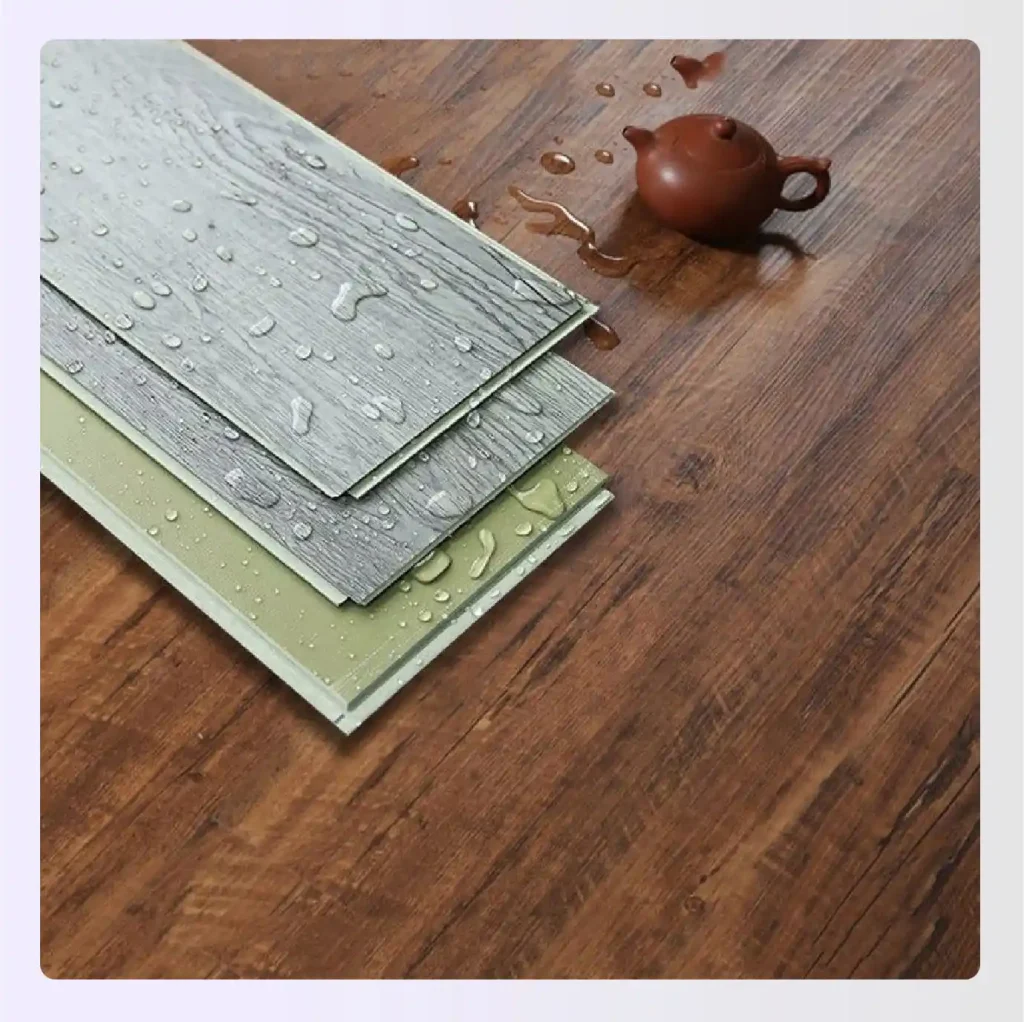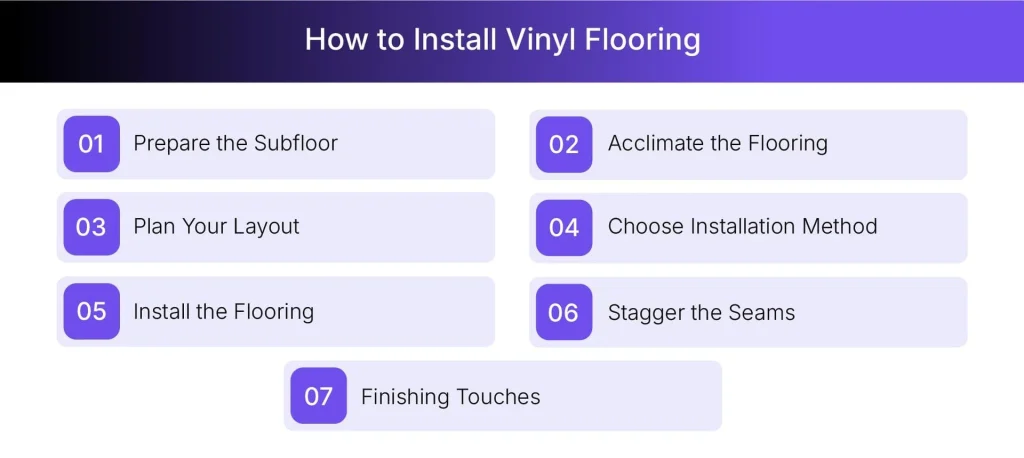Choosing the right flooring for your home can feel overwhelming, especially with so many options available. If you’re considering vinyl, you’re on the right track as it’s one of the most versatile, durable, and budget-friendly flooring materials on the market today.
In this article, we will explore everything you need to know about vinyl flooring, including its types, pros, cons, installation process, and maintenance tips. So, let’s get started!
What is Vinyl Flooring and How Is It Made?
Vinyl flooring is a synthetic flooring material made primarily from polyvinyl chloride (PVC), a durable, flexible plastic derived from petroleum and natural gas. Thanks to modern manufacturing techniques, today’s vinyl flooring can convincingly mimic natural materials like hardwood, stone, and ceramic tile, often at a fraction of the cost.
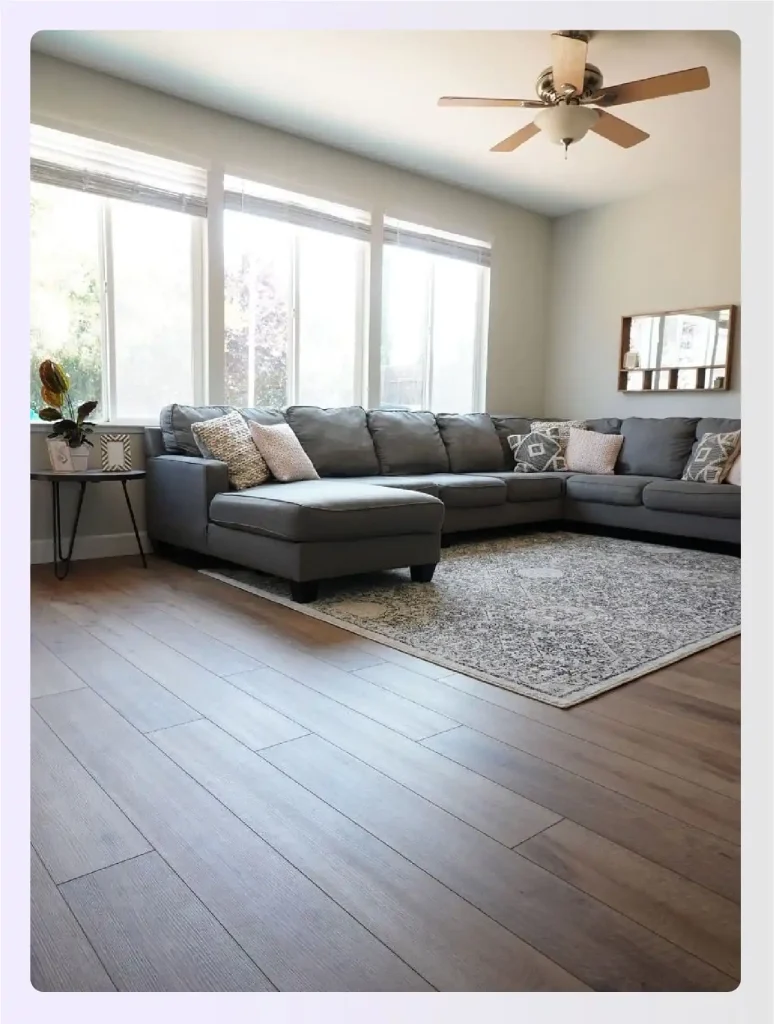
Source: Pinterest
The Manufacturing Process:
The journey from raw materials to finished flooring involves several key steps:
- Compounding: PVC resin is mixed with plasticizers (for flexibility), stabilizers (for durability), and pigments (for color). These components are heated and blended in industrial mixers to create a uniform mixture.
- Calendaring: The compound is rolled into thin sheets using large rollers. The sheets are then cooled and trimmed to the desired thickness, which varies depending on the intended use and quality level.
- Embossing: The vinyl sheets pass through embossing rollers that imprint patterns and textures onto the surface. This is where vinyl gets its realistic wood grain or stone texture appearance, ranging from simple designs to incredibly detailed replicas.
- Wear Layer Application: A clear protective layer of urethane or acrylic is applied on top. This wear layer is crucial as it protects against scratches, stains, and fading, and determines how glossy or matte the finished floor will look.
- Cutting and Packaging: Finally, the sheets are cut into tiles or planks, packaged, and shipped to retailers and distributors.
What makes vinyl flooring special is this multi-layer construction. Most quality vinyl flooring consists of:
- Wear layer (protective coating)
- Design layer (printed pattern)
- Core layer (provides stability and resilience)
- Backing layer (adds cushion and support)
The thickness and quality of each layer directly impacts the flooring’s durability, comfort, and lifespan. Understanding this construction will help you evaluate different vinyl flooring types as we explore them next.
How Many Vinyl Flooring Types Are There?
If you’ve started shopping for vinyl flooring, you’ve probably encountered terms like LVP, LVT, SPC, and WPC, and maybe felt a bit confused. Don’t worry, we’re going to break down the different types of vinyl flooring in simple terms so you can confidently choose the right option.
There are five main vinyl flooring types available today, each designed for different needs, budgets, and aesthetic preferences. Let’s explore each one.
| Vinyl Type | Core Material | Rigidity | Comfort | Best For |
| LVP | PVC/Vinyl | Flexible | Good | Wood-look, general residential |
| LVT | PVC/Vinyl | Flexible | Good | Tile-look, bathrooms |
| Sheet Vinyl | PVC/Vinyl | Flexible | Very Good | Budget projects, large spaces |
| SPC | Stone-Plastic | Very Rigid | Firm | High-traffic, commercial, temp fluctuations |
| WPC | Wood-Plastic | Semi-Rigid | Excellent | Residential, multi-story, comfort-focused |
1. Luxury Vinyl Plank (LVP) – Wood-Look Flooring
Luxury Vinyl Plank, or LVP, is designed to replicate the look and feel of hardwood flooring. These planks are typically 4-7 inches wide and 36-48 inches long, mimicking the size and shape of real wood planks.

Source: Pinterest
Why choose LVP:
- Modern printing technology creates incredibly authentic wood grain patterns and textures
- Unlike real hardwood, LVP handles moisture beautifully
- Slightly softer than hardwood with some give
- Many vinyl plank flooring options feature click-lock systems for DIY installation
Best for: Living rooms, bedrooms, hallways, and even kitchens where you want the warmth and beauty of wood without the maintenance headaches.
2. Luxury Vinyl Tile (LVT) – Stone and Tile Designs
LVT is essentially the tile version of LVP. Instead of wood-look planks, these are designed to mimic ceramic, porcelain, natural stone, or even concrete tiles. They typically come in 12×12, 12×24, or 18×18-inch squares.
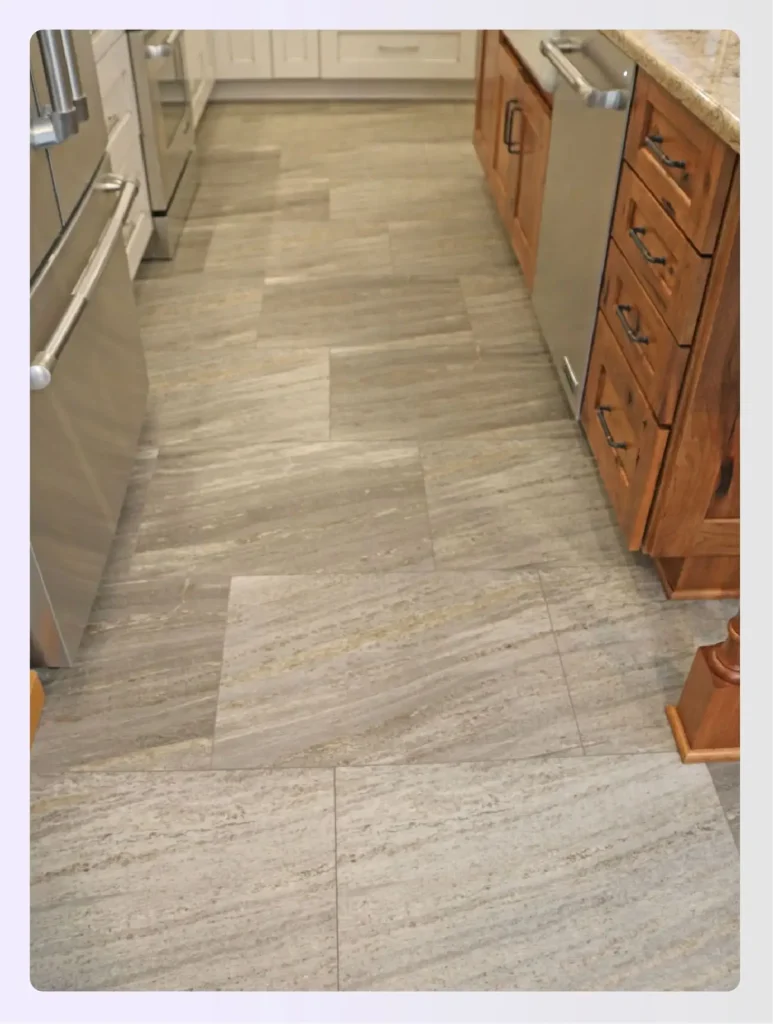
Source: Pinterest
Why choose LVT:
- Perfect for achieving that elegant marble, slate, or travertine look
- Fully waterproof options make it ideal for bathrooms
- More comfortable to stand on than cold ceramic or stone
- Many LVT options install with tight seams, eliminating grout lines
Best for: Bathrooms, entryways, laundry rooms, basements, and kitchens where you want the sophisticated look of tile without the cold, hard surface.
3. Vinyl Sheet Flooring – Budget-Friendly Option
Sheet vinyl is the original vinyl flooring format, available in large rolls (typically 6-12 feet wide). It’s installed as one continuous sheet with minimal or no seams, depending on your room size.
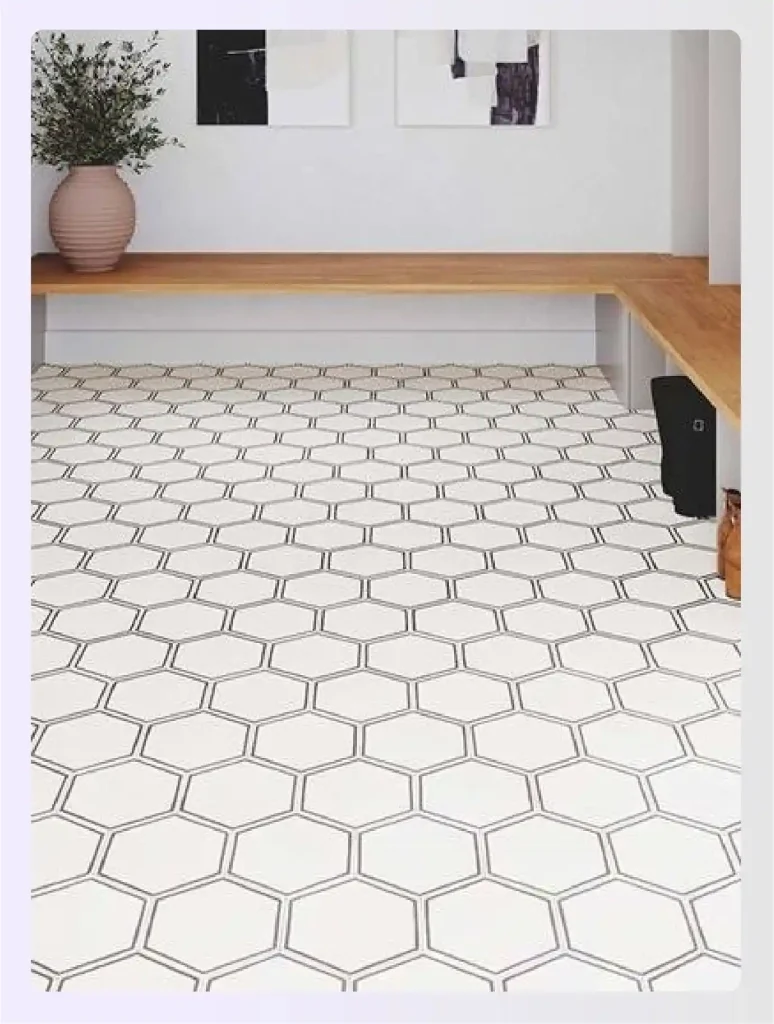
Source: Pinterest
Why choose sheet vinyl:
- Generally the least expensive type of vinyl flooring
- With properly sealed seams, water can’t penetrate
- Smooth surface is easy to clean
- Some sheet vinyl includes foam backing for extra comfort
Best for: Laundry rooms, basements, rental properties, and anywhere you need functional, budget-friendly flooring.
4. SPC Vinyl Flooring (Stone Plastic Composite)
SPC vinyl flooring is one of the newer innovations in vinyl flooring. It features a rigid core made from a mixture of limestone powder and stabilizers, creating an extremely dense, stable product.
Source: Pinterest
Why choose SPC:
- Won’t expand or contract with temperature changes
- The entire plank is waterproof, not just water-resistant
- Dense core resists dents and damage
- Can be installed immediately without waiting for temperature adjustment
- Rigid structure bridges minor subfloor irregularities
Best for: Spaces with temperature fluctuations (sunrooms, basements), high-moisture areas, commercial spaces, and homes with heavy furniture or active families.
5. WPC Vinyl Flooring (Wood Plastic Composite)
WPC vinyl features a core made from a blend of wood pulp and plastic polymers. This creates a flooring that’s more flexible and comfortable than SPC while still being highly durable and waterproof.

- More comfortable to stand on than SPC or traditional vinyl
- Built-in sound dampening reduces noise
- Fully waterproof construction
- Provides slight thermal insulation properties
- The slightly flexible core adapts to minor subfloor irregularities
Best for: Bedrooms, living areas, multi-story homes where sound reduction matters, and anywhere comfort is a priority.
Now that you understand the different vinyl flooring types available, let’s examine the overall pros and cons to help you decide if vinyl is the right choice for your home.
What are the Pros and Cons of Vinyl Flooring?
Before committing to any flooring material, it’s important to weigh the advantages against potential drawbacks. Here’s an honest look at vinyl flooring pros and cons:
| Advantages | Disadvantages |
| 100% waterproof (SPC/WPC types) | Can be scratched or gouged by sharp objects |
| Wide variety of realistic styles (wood, stone, tile) | May fade with prolonged UV exposure |
| Long lifespan: 15-25 years | VOC emissions in some lower-quality products |
| Comfortable and quiet underfoot | Doesn’t add as much resale value as natural materials |
| Very easy to maintain (sweep + damp mop) | Difficult to repair damaged sections |
| Budget-friendly: $0.50-$8 per sq ft | Temperature sensitivity (traditional vinyl) |
| DIY-friendly installation options | Requires thorough subfloor preparation |
| Good for allergy sufferers (non-porous) | Not considered “authentic” premium material |
Advantages of Vinyl Flooring
- One of vinyl’s biggest selling points is its ability to handle moisture. Unlike traditional hardwood (which can warp) or laminate (which can swell), most vinyl flooring, especially SPC and WPC types, is completely waterproof. This makes it ideal for bathrooms, kitchens, laundry rooms, and basements.
- Modern vinyl flooring can mimic virtually any material – oak, maple, marble, slate, concrete, and more. Advanced printing creates remarkably realistic textures that are difficult to distinguish from genuine materials.
- Quality vinyl with a thick wear layer lasts 15-25 years and resists scratches, stains, and daily wear. It’s excellent for busy households with children and pets.
- Vinyl has a slight give that makes it more comfortable than tile or hardwood. It’s naturally quieter underfoot, with many types offering built-in sound dampening.
- Regular sweeping plus occasional damp mopping is all you need. No waxing, refinishing, or special treatments required.
- Vinyl is significantly more affordable than hardwood, tile, or stone for both materials and installation. You can achieve high-end looks at mid-range prices.
- Click-lock LVP and LVT are designed for straightforward DIY installation, saving hundreds or thousands in professional costs.
- Vinyl’s smooth, non-porous surface doesn’t harbor dust mites, pollen, or pet dander like carpet does.
Disadvantages of Vinyl Flooring
- Heavy furniture dragged across vinyl or dropped sharp objects can create cuts, gouges, or dents. Always use furniture pads and lift rather than drag heavy items.
- Prolonged UV exposure can cause fading or discoloration over time. Consider window treatments or choose UV-resistant vinyl for sunny rooms.
- Lower-quality vinyl may emit volatile organic compounds affecting indoor air quality. Look for FloorScore or GreenGuard certified products.
- Vinyl doesn’t add the same resale value as genuine hardwood or stone. For luxury or historic homes, natural materials may be more appropriate.
- Damaged vinyl requires complete plank replacement, which may not match perfectly if the flooring has aged or the product is discontinued.
- Traditional vinyl can expand and contract with temperature changes, potentially causing buckling or gaps. Proper installation with expansion gaps is essential.
- Vinyl shows every subfloor imperfection, which means bumps, dips, or irregularities will be visible. Proper preparation is critical and can add to installation time and costs.
Vinyl flooring is an excellent choice for most homes, especially if you prioritize durability, water resistance, easy maintenance, and budget-consciousness. However, if maximum resale value or authentic natural materials are your top priorities, consider hardwood or natural stone instead.
Which Type of Vinyl Flooring is Best?
The “best” type of vinyl flooring depends entirely on your specific needs, budget, and where you’re installing it. There’s no one-size-fits-all answer, but we can break down the ideal choices for different situations.
Best Vinyl Flooring Types for Kitchens and Bathrooms
Kitchens: Choose WPC if comfort matters (you’ll be standing while cooking). It’s 100% waterproof, resists stains, stays warm underfoot, and handles appliance leaks without issue.
Bathrooms: Choose SPC for maximum stability. Zero water absorption, handles constant humidity, warmer than tile, and no grout lines to clean.
Pro tip: Extend vinyl under vanities, toilets, and appliances for complete moisture protection.
Which Vinyl is Best for High-Traffic Areas?
High-traffic areas like entryways, hallways, living rooms, and commercial spaces need flooring that can withstand constant foot traffic, potential impacts, and daily wear without showing it.
That’s where SPC vinyl flooring wins. The dense, rigid core resists dents from dropped objects and heavy furniture. It won’t compress over time, even where people walk most frequently. SPC offers excellent scratch resistance when paired with a thick wear layer.
The stable dimensions mean no gaps or buckling even with temperature changes. It’s also easy to clean with commercial-grade products if needed.
Which is Better – Vinyl vs Laminate Flooring?
Now that you know which vinyl type works best for different spaces, you might be wondering how vinyl compares to laminate flooring, another popular budget-friendly option. Both are affordable alternatives to hardwood, but they have distinct differences.
If you want to learn more about laminate flooring types, check out our blog post!
Which is Stronger – Vinyl or Laminate?
It depends on what you mean by “stronger.”
Laminate wins for surface hardness and scratch resistance. The top layer is extremely hard and resists abrasions from pets and furniture better. The dense fiberboard core resists compression over time.
Vinyl wins for impact resistance and moisture durability. It’s less likely to crack or chip when something is dropped. More importantly, vinyl won’t be damaged by water, while laminate can swell and be permanently ruined.
Which is Cheaper – Vinyl or Laminate Flooring?
Generally similar, but vinyl offers a wider price range.
Sheet vinyl is typically the most budget-friendly flooring option overall. Standard LVP and LVT fall in the mid-range, while premium SPC and WPC options are at the higher end. Laminate follows a similar pattern, with budget options at the lower end, standard products in the middle, and premium offerings at the top.
Both vinyl and laminate have comparable professional installation costs. Vinyl is generally very DIY-friendly, while laminate is moderately DIY-friendly, which can help you save on labor if you’re handy.
Key Differences Between Vinyl Flooring Types and Laminate
Beyond price and durability, several fundamental differences set these materials apart. Understanding these distinctions will help you choose the right flooring for your specific needs.
| Feature | Vinyl | Laminate |
| Core Material | PVC plastic | Wood fiber (HDF) |
| Water Resistance | Waterproof (SPC/WPC); water-resistant (standard) | Water-resistant surface only; core can swell |
| Comfort | Softer, warmer, quieter underfoot | Harder surface; can be noisy without underlayment |
| Installation | Click-lock, glue-down, or loose-lay | Primarily click-lock floating; requires underlayment |
| Realism | Excellent texture and embossing | Slightly more authentic wood look on premium products |
| Lifespan | 15-25 years | 15-25 years (shorter if moisture damaged) |
| Maintenance | Very easy; damp mop | Easy; avoid excess water |
| Environmental | Plastic-based; some VOC concerns | Wood-based; may contain formaldehyde |
For most homeowners, vinyl is the more versatile and practical choice, especially in homes with moisture concerns, pets, or children. Laminate works beautifully in bedrooms, living rooms, and dining rooms where moisture isn’t an issue.
How Do You Install Vinyl Flooring?
Now that you’ve decided vinyl is right for your space, let’s talk about installation. One of vinyl’s biggest advantages is that many types are DIY-friendly, potentially saving you hundreds or thousands in professional installation costs. The process varies depending on which type you choose, but most follow similar basic principles.
- Prepare Your Subfloor
This is the most critical step. Your subfloor must be clean, dry, and level. Vinyl shows every imperfection (bumps, dips, or irregularities will telegraph through the flooring). Sweep thoroughly, remove any debris, and use a leveling compound to fill low spots or sand down high spots.
- Acclimate Your Flooring
Let vinyl flooring sit in the installation room for 48 hours before installing. This allows it to adjust to the room’s temperature and humidity. Note: SPC vinyl doesn’t require acclimation due to its rigid core.
- Plan Your Layout
Measure your room and plan where planks or tiles will go. Start from the center or longest wall, depending on your room shape. Avoid ending up with very narrow pieces at walls—aim for at least half a plank width on each side.
- Choose Your Installation Method
Click-Lock (Floating): Most popular for DIY. Planks click together and float over the subfloor. No adhesive needed. Works for most LVP, LVT, SPC, and WPC.
Glue-Down: Planks or tiles are glued directly to the subfloor. More permanent and stable but messier and harder to remove. Best for commercial spaces or when maximum stability is needed.
Peel-and-Stick: Tiles have adhesive backing. Peel off the paper and press down. Easiest method but adhesive quality varies.
- Install the Flooring
Start your first row along your chosen wall. Leave a 1/4″ expansion gap around all perimeters (use spacers). For click-lock, connect planks by angling and clicking together. For glue-down, apply adhesive with a notched trowel and press firmly. Cut planks to fit using a utility knife or vinyl cutter.
- Stagger Your Seams
Offset each row by at least 6 inches from the previous row. This creates a more natural look and adds structural stability.
- Add Finishing Touches
Install baseboards or trim to cover expansion gaps. Add transition strips where vinyl meets other flooring types. Clean any adhesive residue immediately if using glue-down method.
How to Clean and Maintain Vinyl Flooring Types?
Once your vinyl flooring is installed and looking beautiful, the next priority is keeping it that way. The good news? Vinyl is one of the easiest flooring materials to maintain. With simple, regular care, your vinyl floors will look great for their entire 15-25 year lifespan.
Daily and Weekly Maintenance
Daily Care
Sweep or use a dry microfiber mop to remove dirt and dust. Wipe up spills immediately with a damp cloth. Place doormats at entries to reduce tracked-in dirt.
Weekly Care
Vacuum with the hard floor attachment (turn off the beater bar to avoid scratches). Damp mop high-traffic areas with a pH-neutral vinyl floor cleaner or simple mixture of warm water and a few drops of dish soap.
Can You Mop Vinyl Flooring?
Yes, absolutely. Mopping is the recommended deep-cleaning method for all vinyl flooring types.
Use a damp mop, not a soaking wet one. Wring out your mop thoroughly. It should be damp to the touch, not dripping. Work in sections and let air dry, or wipe with a dry towel if excess water remains.
Sweep regularly, damp mop occasionally, wipe spills quickly, and protect from furniture damage. That’s it. Follow these simple steps and your vinyl flooring will look beautiful for decades.
How to Choose the Right Type of Vinyl Flooring?
You’ve learned about the different vinyl types, their pros and cons, and how to install them. Now comes the practical part – choosing the right one for your specific project.
What Should You Consider First?
Start by evaluating your room’s conditions. High-moisture areas need SPC or WPC. High-traffic spaces benefit from SPC with thick wear layers. Choose WPC for comfort in kitchens. For tight budgets in low-traffic areas, sheet vinyl or standard LVP works well.
How Do You Balance Budget and Quality?
Consider total project cost, not just material price. Include underlayment, installation, trim, and subfloor prep. Sheet vinyl is cheapest but has fewer styles. Standard LVP and LVT offer good mid-range value. Premium SPC and WPC cost more but deliver superior durability. Buy 10% extra for waste and repairs.
What Style and Technical Features Matter?
Order samples and view them in your space under different lighting. Check wear layer thickness – 12 mil for standard use, 20+ mil for high-traffic. Look for FloorScore or GreenGuard certifications for air quality. Verify warranties cover both wear and waterproofing, not just defects.
Should You DIY or Hire a Professional?
Click-lock vinyl is DIY-friendly if your subfloor is level and you have basic tools. Sheet vinyl and large glue-down projects need professionals. If your subfloor needs extensive prep or repairs, hire help regardless of vinyl type.
Making the right choice is easier when you can see exactly how your flooring will look in your space before you buy. That’s where digital visualization tools become incredibly valuable.
Visualizing Different Vinyl Flooring Types with Foyr Neo
Foyr Neo is a cloud-based interior design software that lets you visualize exactly how different vinyl flooring types will look in your space before purchasing. Instead of relying on small samples and imagination, you can see realistic, full-room renderings with your actual dimensions and lighting conditions.
- Browse thousands of vinyl flooring materials (LVP, LVT, SPC, WPC styles)
- Apply flooring to your digital room with drag-and-drop ease
- Compare multiple vinyl types side-by-side instantly
- View your space in full 3D from multiple angles
- Generate photorealistic renders that look like photographs
- See how flooring coordinates with existing furniture and decor
- Avoid expensive mistakes by testing before buying
- Get family or client buy-in with professional visualizations
Stop guessing and start visualizing. Design your space with confidence using Foyr Neo. Start your 14 day trial today!
Frequently Asked Questions About Vinyl Flooring Types
What style vinyl flooring is best?
Medium-toned wood-look LVP in oak or maple works with any decor. Modern spaces suit wide-plank (7″+) gray tones. Traditional homes benefit from narrow planks in warm woods. Bathrooms look elegant with marble-look LVT. Choose embossing-in-register (EIR) for authentic texture.
What is another name for vinyl flooring?
Vinyl flooring is also called LVP (Luxury Vinyl Plank), LVT (Luxury Vinyl Tile), luxury vinyl, resilient flooring, or PVC flooring. Other terms include vinyl planks, cushion vinyl (sheet with foam), and VCT (commercial tiles). LVP, LVT, SPC, and WPC are standard modern terms.
What is the disadvantage of vinyl flooring?
Main disadvantages include damage from sharp objects requiring plank replacement (can’t be refinished like hardwood), lower resale value than natural materials, potential UV fading, VOC emissions in cheap products, and temperature sensitivity in traditional vinyl without proper expansion gaps during installation.
Do You Need Underlay for Vinyl Flooring?
Depends on the product. Need it for floating vinyl on concrete, second floors (sound), or thin vinyl under 4mm. Don’t need it if vinyl has attached underlayment (most modern products), for glue-down, or if prohibited. Check specifications, wrong underlayment voids warranties.
Is Vinyl Flooring 100% Waterproof?
Premium SPC and WPC are 100% waterproof. High-quality LVP/LVT often are too. Standard vinyl may only be water-resistant on surface. Look for “100% waterproof” or “waterproof core” labels and check warranties. Proper installation with sealed seams is critical.


